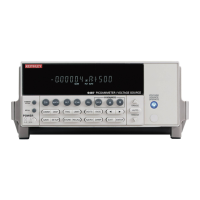G-16 Applications Guide Model 6487 Reference Manual
Steps to minimize impact of range change transients
When changing between the following range pairs (up or down), no input transients occur:
2nA and 20nA, 200nA and 2μA, 20μA and 200μA, 2mA and 20mA. This is not true when
auto-ranging upwards across these boundaries.
Run test with a fixed range
If possible, run the test within a fixed range. Choose the higher range from any of the
range pairs listed above. Alternatively, the autorange upper limit
(:RANGe:AUTO:ULIMit, see “Noise and safety shields” or “Autorange limits” in the
6487 User’s Manual) can be set so that the internal limiting resistor (R
F
) cannot be
reduced to the lower values. Choose the appropriate range to accommodate the maximum
current expected during normal measurements.
Down-range by starting at highest current necessary
Make use of down-ranging by starting at the highest current necessary and reducing down
to zero, the range change transients can be reduced significantly compared to up-ranging
transients.
Using protection circuitry
Using protection circuitry can greatly reduce currents and voltages presented to devices
being tested, as well as serving to protect the Model 6487 from any externally generated
transients. If using the scheme from “Noise and safety shields” in the 6487 User’s Manual,
size the external current limiting resistor such that the sum of the external resistor and the
lowest R
F
will limit a 10V transient to a current level acceptable to the DUT.
Reduce up-ranging transient
If the application requires that up-ranging be used, and when the transient through the
internal limiting resistor R
F
would damage the DUT, the up-ranging transient can be
reduced greatly by reducing the input current to <10% of the present range before forcing
the range change up (manual or fixed-ranging over the bus). This can be true when running
the first I-V curve on devices whose characteristics are not yet known, so that sweeping
from low current towards high current is the only way to avoid exceeding a maximum cur-
rent through the device.

